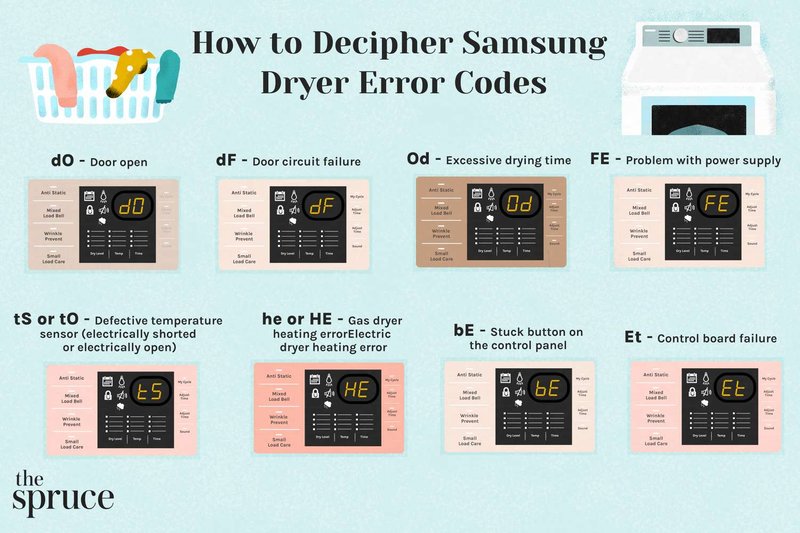
The E2 error code usually indicates a problem with the thermistor, a small but crucial component of your dryer that ensures everything is operating at the right temperature. Imagine the thermistor like a thermostat in your house that keeps track of the temperature and tells the heater when to kick on or off. When this part acts up, your dryer might have trouble drying clothes properly, leading to endless cycles and a lot of frustration. But don’t worry—by understanding the common causes of this hiccup, you can troubleshoot it yourself or know when it’s time to call in the pros.
Understanding the Role of the Thermistor
To grasp why the E2 error appears, it helps to understand what a thermistor does. The thermistor in your Samsung dryer is like the conductor of an orchestra, ensuring that every element involved in the heating process performs at the right tempo. This small sensor reads the air temperature inside the dryer and sends this information to the dryer’s control board. Based on these readings, the control board decides how much heat is needed to dry your clothes effectively.
When the thermistor is faulty, it’s like trying to play music with a conductor who’s off beat. The control board gets confused, and as a result, your dryer might either overheat or not heat at all. This scenario can cause the dryer to stop its cycle prematurely and flash the E2 error code, indicating that the temperature readings aren’t making sense.
You might be wondering how a thermistor gets damaged or fails. The reasons range from natural wear and tear, just like shoes eventually wear out, to issues like lint buildup or moisture, which can affect its accuracy. It’s crucial to keep your dryer’s components clean and dry to avoid such problems.
Common Causes Of Error Code E2
One of the primary culprits behind the E2 error code is a defective thermistor. Just like a faulty thermometer can’t give you an accurate body temperature, a problematic thermistor fails to provide correct readings to the dryer’s control board. This faulty information leads the dryer to misinterpret internal conditions, causing it to shut down to prevent any potential damage.
Another common cause is wiring issues connecting the thermistor to the control board. Think of it like a string of holiday lights—if one wire is faulty, the whole string might flicker or go out. Similarly, if the wiring is loose, frayed, or disconnected, the thermistor can’t communicate with the control board properly, leading to an E2 error.
Lastly, external factors such as excessive lint or moisture can affect the thermistor’s functionality. Lint, which accumulates from clothes during drying, can clog the dryer’s internal components, leading to overheating and inaccurate temperature readings. Moisture, especially if the dryer isn’t properly vented, can cause the thermistor to give faulty readings.
Solutions and Preventative Measures
Here’s the deal: addressing an E2 error code might feel daunting, but with a little guidance, you can tackle it like a pro. Start by unplugging your dryer to ensure safety, then locate the thermistor, usually near the blower housing. If you’re comfortable with DIY tasks, you can use a multimeter to check if it’s functioning correctly. If it’s defective, replacing it may solve the problem.
Next, inspect the wiring. Tighten any loose connections, and if you spot any damaged wires, you might need professional help to replace them. It’s like fixing a frayed phone charger—sometimes a quick repair solves the issue, but other times, a replacement is essential.
To prevent future issues, regularly clean the lint filter and exhaust vent. This simple step helps maintain proper airflow and prevents overheating. It’s like giving your space heater a dusting—it keeps everything running smoothly by ensuring no blockages affect performance. Also, ensure your dryer is placed in a well-ventilated area to minimize moisture accumulation.
When to Seek Professional Help
Despite your best efforts, there might be times when the E2 error persists. If you’ve checked the thermistor and wiring but still see the error code, it might be time to call in a professional. Just like with complex car repairs, some dryer issues require expert knowledge and tools to fix.
A technician can perform a more comprehensive diagnostic to identify other potential causes, such as a faulty control board. It’s always better to seek help rather than risk damaging your appliance. Remember, while DIY solutions are fantastic, there’s no shame in getting expert assistance to keep your dryer running efficiently.
In conclusion, while an E2 error code can be frustrating, understanding its causes and solutions can save you time and stress. By keeping your dryer well-maintained and knowing when to seek professional help, you can ensure your laundry routine stays on track without hiccups.